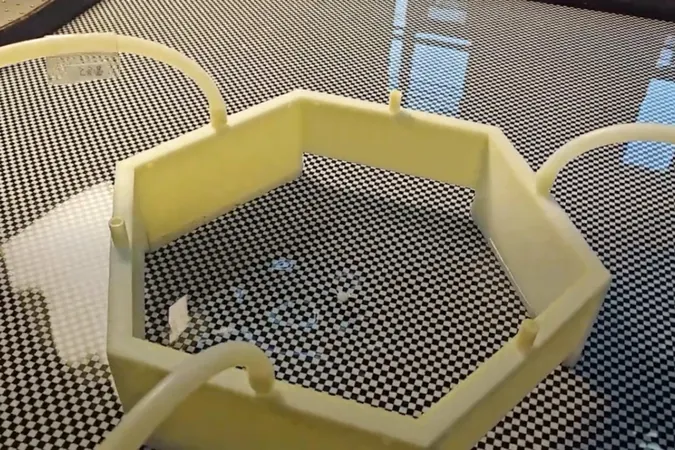
Harnessing the Power of Waves: Revolutionary Technique Steers Objects on Water Like Magic!
2025-03-16
Author: Wei
Introduction
Imagine relaxing on a large float in a serene lake, only to find yourself completely stuck without a paddle or sail. It's a situation we all know too well. But what if I told you that researchers have come up with a groundbreaking method that allows water itself to navigate objects with incredible precision?
A Revolutionary Technique
An international team of scientists has unveiled a technique that manipulates waves—like something straight out of a science fiction novel. This innovative approach may have far-reaching implications, from pioneering molecular experiments to controlling the movement of boats over vast waterways.
Mechanics of Wave Manipulation
This wave manipulation technique utilizes specially designed structures that create different types of water waves in a controlled tank environment. One of the key tools in their arsenal resembles a ring equipped with 24 tubes linked to speakers, generating low-frequency sounds that produce ripples throughout the water contained within.
Precision Control of Floating Objects
By adjusting the amplitude and frequency of these waves, researchers have crafted complex surface patterns—such as loops and spirals—enabling precise control of floating objects, including foam and ping pong balls, as well as grains of rice.
Research Findings
In a study published recently in the reputable journal Nature, they detailed their exciting findings. Using waves, they mastered techniques that allowed them to stabilize floating objects in place or guide them along circular and spiral routes—keeping their movement remarkably undisturbed by external waves, deviating by less than 5 millimeters from their intended paths. Despite the apparent magic, it's all firmly rooted in the laws of physics.
Future Applications and Potential
As Shen Yijie, co-lead of the study from Nanyang Technological University in Singapore, stated, 'Our research is just the beginning. We’re exploring the vast potential of water waves to move objects accurately, opening up numerous possibilities for future applications.'
Inspiration and Insights
Yijie, who specializes in optics, drew inspiration from his work on light patterns that previously demonstrated the capacity of light waves to maneuver tiny particles, sparking his curiosity about the potential of water waves.
The Molecular and Broader Scope
'If we can manipulate waves to move particles as small as rice grains, imagine the possibilities,' Yijie added. 'We could eventually explore even smaller scales, like those at the cellular level, or harness the power of much larger ocean waves.'
Challenges Ahead
On a molecular scale, this technique could potentially aggregate particles without any direct physical manipulation, and on a broader scale, it could facilitate the navigation of boats. However, researchers are cautious about the challenges posed by strong natural waves, which would need to be accounted for in real-world applications.
Potential in Cleanup Efforts
But wait—could we use this technology to move liquids within water? This technique might prove vital in addressing the cleanup of floating chemical pollutants. Keep in mind, however, that significant wave-generating structures might be needed when working in larger water bodies.
Cross-Disciplinary Insights
Interestingly, researchers also draw parallels between water waves, light waves, and electron behavior. They suggest that studying water waves could be a simpler gateway to understanding complex quantum phenomena. And if that’s not mind-blowing enough, future studies might even investigate the prospect of using water patterns for data storage!
Conclusion and Outlook
For now, the team is focusing on exploring whether their wave techniques can create similar patterns beneath the water's surface, heralding a new era in both scientific research and potential technological advancements. Stay tuned, because the possibilities are just beginning to ripple out!
Final Thoughts
Are we on the verge of a water-bending revolution? The answer may surprise you!





 Brasil (PT)
Brasil (PT)
 Canada (EN)
Canada (EN)
 Chile (ES)
Chile (ES)
 Česko (CS)
Česko (CS)
 대한민국 (KO)
대한민국 (KO)
 España (ES)
España (ES)
 France (FR)
France (FR)
 Hong Kong (EN)
Hong Kong (EN)
 Italia (IT)
Italia (IT)
 日本 (JA)
日本 (JA)
 Magyarország (HU)
Magyarország (HU)
 Norge (NO)
Norge (NO)
 Polska (PL)
Polska (PL)
 Schweiz (DE)
Schweiz (DE)
 Singapore (EN)
Singapore (EN)
 Sverige (SV)
Sverige (SV)
 Suomi (FI)
Suomi (FI)
 Türkiye (TR)
Türkiye (TR)
 الإمارات العربية المتحدة (AR)
الإمارات العربية المتحدة (AR)